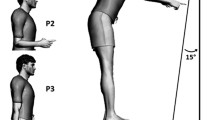Abstract
Reaching movements are associated with widespread, nonfocal muscle activity. That activity is often assumed to play a postural role. We tested this assumption for the trunk muscles at the initiation of reaching movements with the following question. Does initial trunk muscle activity play a dynamic postural role by resisting the segmental interactive effects of the arm movement on the trunk? Seated subjects performed bilateral reaching movements while target direction was systematically varied. Muscle activity was recorded from flexors and extensors of the trunk and shoulder. Trunk muscle activity was compared with trunk torques calculated from simulations of reaching movements in which the trunk was modeled to stay still. Recorded trunk muscle activity was in qualitative agreement with torque predictions for only some target directions, suggesting that the nervous system does not activate trunk muscles across all target directions to counteract postural disturbances at the initiation of reaching movements.
Similar content being viewed by others
References
Atkeson CG, Hollerbach JM (1985) Kinematic features of unrestrained vertical arm movements. J Neurosci 5:2318–2330
Belen'kii VY, Gurfinkel VS, Pal'tsev YI (1967) Elements of control of voluntary movements. Biofizika 12:135–141
Bernstein N (1967) The co-ordination and regulation of movements. Pergamon, Oxford
Bouisset S, Zattara M (1988) Anticipatory postural adjustments and dynamic asymmetry of voluntary movement. In: Gurfmkel VS, Ioffe ME, Massion J, Roll JP (eds) Stance and motion facts and concepts. Plenum, New York, pp 177–183
Clément G, Gurfinkel VS, Lestienne F, Lipshits MI, Popov KE (1984) Adaptation of postural control to weightlessness. Exp Brain Res 57:61–72
Cordo PJ, Nashner LM (1982) Properties of postural adjustments associated with rapid arm movements. J Neurophysiol 47:287–302
Friedli WG, Hallett M, Simon SR (1984) Postural adjustments associated with rapid voluntary arm movements. 1. Electromyographic data. J Neurol Neurosurg Psychiatr 47:611–622
Gurfinkel VS, Lipshits MI, Lestienne FG (1988) Anticipatory neck muscle activity associated with rapid arm movements. Neurosci Lett 94:104–108
Hollerbach JM, Flash T (1982) Dynamic interactions between limb segments during planar arm movement. Biol Cybern 44:67–77
Horak FB, Esselman P, Anderson ME, Lynch MK (1984) The effects of movement velocity, mass displaced, and task certainty on associated postural adjustments made by normal and hemiplegic individuals. J Neurol Neurosurg Psychiatr 47:1020–1028
Hoy MG, Zernicke RF (1985) Modulation of limb dynamics in the swing phase of locomotion. J Biomech 18:49–60
Iannone AM, Hallett M, Stanhope S, Vail R (1991) Arm and trunk synergies in pointing movements in normal subjects and patients with cerebellar defecits. Soc Neurosci Abstr 17:1387
Kaminski TR, Bock C, Gentile AM (1992) Coordination between arm and trunk motion during rapid pointing movements. Soc Neurosci Abstr 18:518
Lee WA (1980) Anticipatory control of postural and task muscles during rapid arm flexion. J Mot Behav 12:185–196
Lee WA, Buchanan TS, Rogers MW (1987) Effects of arm acceleration and behavioral conditions on the organization of postural adjustments during arm flexion. Exp Brain Res 66:257–270
Morasso P (1981) Spatial control of arm movements. Exp Brain Res 42:223–227
Oddsson L, Thorstensson A (1987) Fast voluntary trunk flexion movements in standing: motor patterns. Acta Physiol Scand 129:93–106
Ramos CF, Stark LW (1990) Postural maintenance during movement: simulations of a two joint model. Biol Cybern 63:363–375
Soechting JF, Flanders M (1991) Arm movements in three-dimensional space: computation, theory, and observation. Exerc Sport Sci Rev 19:389–418
Tyler AE, Kasan Z (1991) Trunk muscle activity during vertical plane rapid arm movements while sitting. Soc Neurosci Abstr 17:1385
Tyler AE, Hasan Z (1993) Trunk muscle EMG during arm reaching for different target directions and target distances. Soc Neurosci 19:151
Tyler AE (1994) The action of trunk muscles in arm reaching tasks. Dissertation, University of Arizona
Woollacott MH, Bonnet M, Yabe K (1984) Preparatory process for anticipatory postural adjustments: modulation of leg muscles reflex pathways during preparation for arm movements in standing man. Exp Brain Res 55:263–271
Zajac FE, Gordon ME (1989) Determining muscle's force and action in multi-articular movement. Exerc Sport Sci Rev 17:187–230
Zatsiorsky V, Seluyanov V (1983) The mass and inertia characteristics of the main segments of the human body. In: Matsui H, Kobayashi K (eds) Biomechanics VIII-B. Human Kinetics, Champaign, Ill, pp 1152–1159
Author information
Authors and Affiliations
Rights and permissions
About this article
Cite this article
Tyler, A.E., Hasan, Z. Qualitative discrepancies between trunk muscle activity and dynamic postural requirements at the initiation of reaching movements performed while sitting. Exp Brain Res 107, 87–95 (1995). https://doi.org/10.1007/BF00228020
Received:
Accepted:
Issue Date:
DOI: https://doi.org/10.1007/BF00228020




